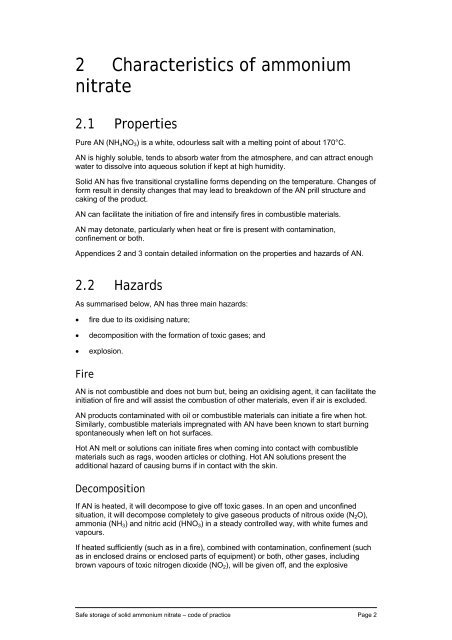Safe storage of solid ammonium nitrate Code of practice
Safe storage of solid ammonium nitrate Code of practice
Safe storage of solid ammonium nitrate Code of practice
You also want an ePaper? Increase the reach of your titles
YUMPU automatically turns print PDFs into web optimized ePapers that Google loves.
2 Characteristics <strong>of</strong> <strong>ammonium</strong><br />
<strong>nitrate</strong><br />
2.1 Properties<br />
Pure AN (NH4NO3) is a white, odourless salt with a melting point <strong>of</strong> about 170°C.<br />
AN is highly soluble, tends to absorb water from the atmosphere, and can attract enough<br />
water to dissolve into aqueous solution if kept at high humidity.<br />
Solid AN has five transitional crystalline forms depending on the temperature. Changes <strong>of</strong><br />
form result in density changes that may lead to breakdown <strong>of</strong> the AN prill structure and<br />
caking <strong>of</strong> the product.<br />
AN can facilitate the initiation <strong>of</strong> fire and intensify fires in combustible materials.<br />
AN may detonate, particularly when heat or fire is present with contamination,<br />
confinement or both.<br />
Appendices 2 and 3 contain detailed information on the properties and hazards <strong>of</strong> AN.<br />
2.2 Hazards<br />
As summarised below, AN has three main hazards:<br />
• fire due to its oxidising nature;<br />
• decomposition with the formation <strong>of</strong> toxic gases; and<br />
• explosion.<br />
Fire<br />
AN is not combustible and does not burn but, being an oxidising agent, it can facilitate the<br />
initiation <strong>of</strong> fire and will assist the combustion <strong>of</strong> other materials, even if air is excluded.<br />
AN products contaminated with oil or combustible materials can initiate a fire when hot.<br />
Similarly, combustible materials impregnated with AN have been known to start burning<br />
spontaneously when left on hot surfaces.<br />
Hot AN melt or solutions can initiate fires when coming into contact with combustible<br />
materials such as rags, wooden articles or clothing. Hot AN solutions present the<br />
additional hazard <strong>of</strong> causing burns if in contact with the skin.<br />
Decomposition<br />
If AN is heated, it will decompose to give <strong>of</strong>f toxic gases. In an open and unconfined<br />
situation, it will decompose completely to give gaseous products <strong>of</strong> nitrous oxide (N2O),<br />
ammonia (NH3) and nitric acid (HNO3) in a steady controlled way, with white fumes and<br />
vapours.<br />
If heated sufficiently (such as in a fire), combined with contamination, confinement (such<br />
as in enclosed drains or enclosed parts <strong>of</strong> equipment) or both, other gases, including<br />
brown vapours <strong>of</strong> toxic nitrogen dioxide (NO2), will be given <strong>of</strong>f, and the explosive<br />
<strong>Safe</strong> <strong>storage</strong> <strong>of</strong> <strong>solid</strong> <strong>ammonium</strong> <strong>nitrate</strong> – code <strong>of</strong> <strong>practice</strong> Page 2

















